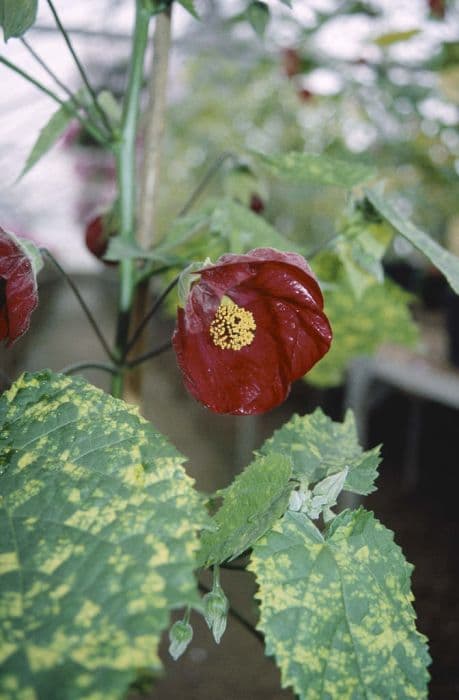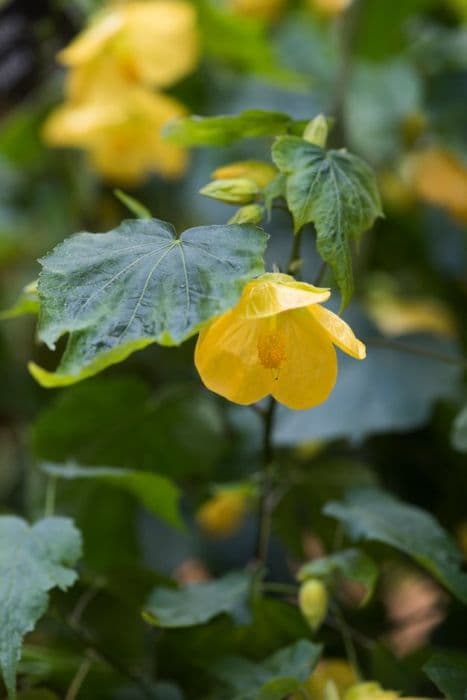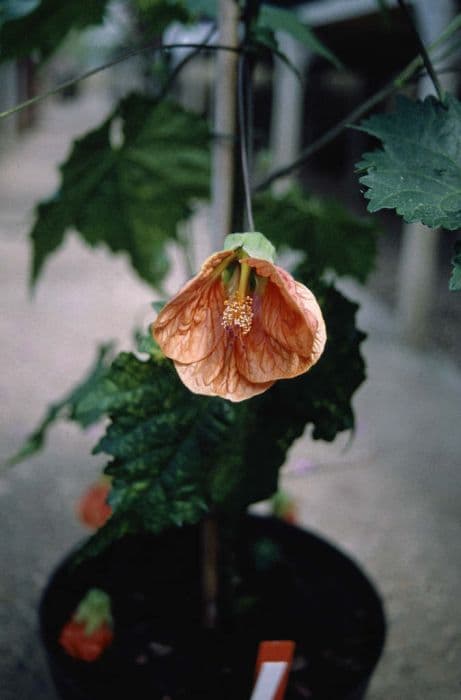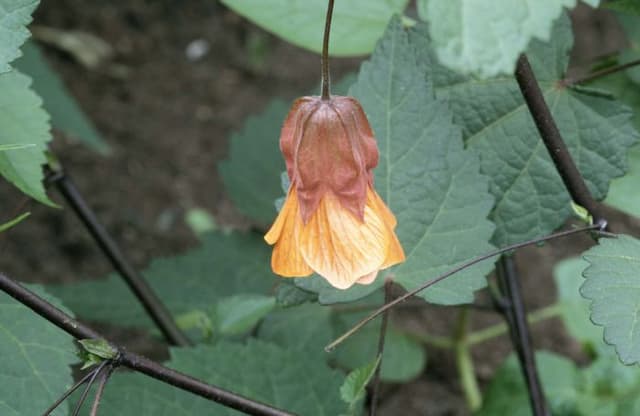Chilean Tree Mallow Corynabutilon vitifolium 'Veronica Tennant'

ABOUT
The Corynabutilon vitifolium 'Veronica Tennant', commonly known as the Chilean bellflower, is adorned with large, lobed leaves that are similar in shape to those of grapevines, granting it a lush, green backdrop. From this verdant foliage, the plant produces striking flowers that hang gracefully. Distinctive in form, these blooms are bell-shaped and bear a resemblance to dainty petticoats. They display soft hues commonly in shades of pink or lavender, exuding a delicate charm with their pastel tones. Each flower features a prominent, contrasting center that often appears in a deeper shade, catching the eye and adding depth to the overall floral display. The Chilean bellflower has a growth habit that is both elegant and spreading, capable of creating a cascading effect with its stems and blooms. Its overall appearance is one that can add a touch of romantic allure to any garden or landscape setting, showcasing the inherent beauty of this cultivar through its foliage and floriferous display.
About this plant
 Names
NamesFamily
Malvaceae
Synonyms
Chilean Tree Mallow, Whitney
Common names
Abutilon vitifolium (Cav.) C.Presl, Sida vitifolia Cav.
 Toxicity
ToxicityTo humans
The common name for Corynabutilon vitifolium 'Veronica Tennant' is Chilean tree mallow. There is limited information available regarding the toxicity of Chilean tree mallow specifically to humans. However, it generally is not listed among commonly toxic plants. As with many plants, sensitive individuals may experience mild irritation or an allergic reaction upon contact with the sap or after ingesting plant parts. Without specific toxicological data or a well-documented history of poisoning, it is not possible to provide an accurate account of symptoms or consequences of poisoning for this particular cultivar. If ingestion or contact occurs and adverse reactions are experienced, it is advisable to consult a medical professional.
To pets
The common name for Corynabutilon vitifolium 'Veronica Tennant' is Chilean tree mallow. There is limited information regarding the toxicity of this plant to pets. Not being listed among the most common toxic plants for animals implies that the Chilean tree mallow might not be significantly poisonous. However, as general advice, pets should not be allowed to ingest plants, especially not in large quantities or any part of an unknown plant, due to the risk of gastrointestinal upset or more serious health issues. If a pet does ingest this plant and shows signs of illness, such as vomiting, diarrhea, or unusual behavior, it is important to consult a veterinarian promptly.
 Characteristics
CharacteristicsLife cycle
Perennials
Foliage type
Semi-deciduous
Color of leaves
Green
Flower color
Pink
Height
6-8 feet (1.8-2.4 meters)
Spread
6 feet (1.8 meters)
Plant type
Shrub
Hardiness zones
8
Native area
Chile
Benefits
 General Benefits
General Benefits- Aesthetic Appeal: Adds beauty to gardens with its attractive foliage and pink flowers.
- Wildlife Attraction: Flowers can attract pollinators like bees and butterflies, promoting biodiversity.
- Shade Provider: Large leaves can create a cool, shaded area in gardens or patios.
- Privacy Screen: When planted in groups, it can serve as a natural privacy screen.
- Low Maintenance: Requires minimal care once established, which can save time and effort for gardeners.
- Drought Tolerance: Once established, it can tolerate periods of drought, making it suitable for xeriscaping.
- Versatility: Can be grown both in the ground and containers, increasing its versatility in landscaping.
- Seasonal Interest: Provides visual interest throughout its blooming season.
 Medical Properties
Medical PropertiesThis plant is not used for medical purposes.
 Air-purifying Qualities
Air-purifying QualitiesThis plant is not specifically known for air purifying qualities.
 Other Uses
Other Uses- Corynabutilon vitifolium 'Veronica Tennant', commonly known as Chilean tree mallow, can be used in floral arrangements thanks to its lush foliage and large, showy flowers, providing a tropic-like flair.
- Its dried seed pods can be used for crafting, such as in wreaths or as a natural decor in mixed dry arrangements.
- The Chilean tree mallow's fast growth and large size make it a suitable choice for temporary screening in a garden or for providing quick shade for smaller plants.
- Its broad leaves can be used as a natural wrapping material for small packages, giving gifts a unique, botanical touch.
- The fiber from the stems of the plant can be experimented with for making paper or for including in paper-making workshops.
- Chilean tree mallow can be planted for educational purposes, such as teaching botany or horticulture due to its interesting morphology and growth habits.
- The plant's vibrant flowers attract pollinators, making it a beneficial addition to support local bee and butterfly populations.
- Used in theatrical set designs, the Chilean tree mallow can lend an exotic backdrop to productions requiring a lush, floral setting.
- Photographers might use the plant as a live backdrop for spring and summer-themed photoshoots, thanks to its height and attractive blooms.
- As a subject for painting or drawing classes, the Chilean tree mallow offers art students a rich source of organic forms and colors to study and replicate.
Interesting Facts
 Feng Shui
Feng ShuiThe Chilean bellflower is not used in Feng Shui practice.
 Zodiac Sign Compitability
Zodiac Sign CompitabilityThe Chilean bellflower is not used in astrology practice.
 Plant Symbolism
Plant Symbolism- Resilience: Corynabutilon vitifolium, commonly known as Chilean tree mallow, often symbolizes resilience because it can adapt to various climates and conditions, showcasing its ability to endure and thrive.
- Beauty: The 'Veronica Tennant' cultivar, with its elegant pink flowers, is often associated with beauty, reflecting the aesthetic grace of the ballet dancer for whom it is named.
- Grace: Inspired by Veronica Tennant's ballet career, the plant represents gracefulness, as it sways beautifully in the breeze much like a dancer moves on stage.
 Water
WaterThe Chilean tree mallow requires consistent moisture and should be watered deeply once a week during the growing season. During hot or dry periods, water twice a week, supplying about 1-2 gallons per plant depending on size. Reduce watering in the winter to every other week or when the top inch of soil feels dry to the touch. It's important to avoid waterlogging, so ensure that the plant has well-draining soil to prevent root rot.
 Light
LightThe Chilean tree mallow prefers full sun to partial shade conditions. It thrives best when it receives at least six hours of direct sunlight daily. Choosing a spot that gets morning sunlight and some afternoon shade is beneficial, especially in hotter climates to prevent scorching.
 Temperature
TemperatureThe Chilean tree mallow tolerates a range of temperatures but grows best in conditions between 50°F and 85°F. It can survive minimum temperatures of around 20°F but should be protected from frost. During the summer, if temperatures consistently exceed 85°F, providing some afternoon shade can help protect the plant.
 Pruning
PruningPrune the Chilean tree mallow to maintain its shape and encourage bushier growth. Pruning can be done in late winter or early spring before new growth begins. Remove any dead or damaged branches and cut back up to one-third of the plant to promote healthy new shoots. Pruning can also stimulate flowering, so a yearly trim is beneficial.
 Cleaning
CleaningAs needed
 Soil
SoilChilean Tree Mallow prefers well-draining soil with a mix of loam, peat, and sand. Ensure a soil pH between 6.0 to 7.5 for optimal growth.
 Repotting
RepottingChilean Tree Mallow should be repotted every 2 to 3 years to refresh the soil and accommodate root growth.
 Humidity & Misting
Humidity & MistingChilean Tree Mallow thrives at average room humidity levels; no specific requirements, just avoid overly dry air.
 Suitable locations
Suitable locationsIndoor
Place in bright, indirect light and water when topsoil is dry.
Outdoor
Needs full sun to partial shade and shelter from strong winds.
Hardiness zone
8-10 USDA
 Life cycle
Life cycleCorynabutilon vitifolium 'Veronica Tennant', commonly known as Chilean Tree Mallow, begins its life cycle as a seed, which upon germination develops a taproot and cotyledons (seed leaves). As it grows, the plant forms a woody-based perennial subshrub with heart-shaped leaves, and after a period of vegetative growth, it will start to produce flower buds. These buds eventually bloom into its characteristic large, bell-shaped, pale pink to white flowers during the warmer months. Following pollination, typically by insects, the flowers develop into dry, five-celled schizocarps (a type of fruit) which contain the seeds for the next generation. During colder months, if situated in climates with frosts, the above-ground part of the plant may die back, retreating to its woody base. In the following spring, the plant will resprout from this base, continuing its life cycle, or the fallen seeds will germinate to give rise to new individuals.
 Propogation
PropogationPropogation time
Spring-Early Summer
The most popular method of propagating the Chilean Bellflower, Corynabutilon vitifolium 'Veronica Tennant', is through semi-hardwood cuttings. This typically takes place during the warmer months, usually from late spring through to early summer, when the plant's growth is most vigorous. To propagate by cuttings, a gardener would select a healthy, non-flowering stem and cut a segment of about 4 to 6 inches (approximately 10 to 15 centimeters) in length. The lower leaves should be removed and the cut end can be dipped in a rooting hormone to encourage root development. The prepared cutting is then inserted into a pot filled with a mixture of peat and perlite or any well-draining potting mix. Keeping the soil consistently moist and providing a humid atmosphere, for instance by covering the pot with a plastic bag, aids the rooting process. After a few weeks, the cuttings should develop roots and can be further nurtured to grow into new Chilean Bellflower plants.





![Abutilon [Yellow Trumpet]](/_next/image?url=https%3A%2F%2Fplants-admin.emdemapps.com%2Fimages%2Fplants%2F%2Fimages%2F604b5caa8b4fb.png&w=640&q=75)


